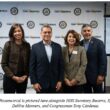Back to basics
Before the advent of Internet chat rooms, amateur radio — or ham radio — provided a way to communicate with kindred spirits in other parts of the country. Before voice-over-IP applications let users talk worldwide for little or no money, amateur radio was the cost-effective method to talk overseas on a regular basis. Before cellular technology became commonplace, portable amateur radio units were the only way to make phone calls from a car.
As the amateur-radio community celebrates 100 years of voice over radio (see timeline), ham enthusiasts happily recount their first encounters with the technology and what attracted them to it — typically as excited teenagers.
“To me, when I was a high-school kid in the mid ‘60s, I would come home from school and turn on the radio and talk to Bulgaria,” said David Sumner, CEO of American Radio Relay League, or ARRL, the national association of amateur radio. “This was back in the days of the Iron Curtain, and it was a pretty neat thing to be able to do that.”
But most hams are not teens anymore. The Baby Boomers who represent the core of the amateur-radio community are aging, and the median age of hams today is 50 to 55, by most accounts — a fact that is increasingly evident to attendees of the large ham-radio convention conducted annually in Dayton, Ohio.
“My biggest concern when I go there is getting run over by those three-wheeled carts,” said Stan Reubenstein of the Radio Club of America (RCA).
Attracting more youngsters to ham radio is a goal of the RCA and ARRL, but the task is easier said than done. Cell phones and Internet-connected computers are readily available, and even some video games enable VoIP communication with a competitor halfway around the world. Having to pass a licensing test to communicate via ham radio is not nearly as attractive as these instant-gratification alternatives that can be found in multiple retail outlets, said Don Root, who is leading an amateur-radio task force for the Association of Public-Safety Communications Officials (APCO).
“Cell phones are readily available, and they can talk to their friends, so why should they study and learn technology and operating procedures to go out and get a ham radio?” Root said. “I don’t see that there’s a strong draw there.”
NOT JUST A HOBBY
Ham radio technically is a hobby, and interest in any hobby tends to ebb and flow amid generational changes. But while a decrease in Hula Hoop sales or a waning of interest in quilting may be worthy of a trivial mention in a newscast feature, maintaining momentum in ham radio has societal implications not associated with other hobbies.
That’s because, even though rules dictate that they cannot be compensated, amateur-radio operators can render services that arguably are priceless. During the Cold War, it was the only way to talk to people in some communist countries, and the British relied on ham radio to deliver information during the Falklands War when the Argentine government seized control of communications on the islands.
But perhaps the most notable instances of ham-radio use have occurred in the last two years, when natural disasters — a massive tsunami hitting Southeast Asia and India in December 2004 and Hurricane Katrina striking the Gulf Coast last year — disabled even the most sophisticated communications networks. Requiring little power and no supporting infrastructure, ham-radio communications were invaluable in both instances.
“The only other service that really can do that is mobile satellite service,” ARRL’s Sumner said. “Mobile satellite is terrific in disaster communications and communicating out of areas; on the other hand, it’s expensive and still fairly scarce. So we believe there will continue to be a role for amateur radio for quite some time — until we all have satellite phones dangling from our belts.”
While these dire circumstances exemplify a significant tangible benefit of amateur radio, the technology has brought untold intangible value to the technological community. Many of today’s communications professionals say their start in the industry began by discovering amateur radio. Intrado Chief Technology Officer Stephen Meer said ham radio differs from other communication alternatives because operators can learn how the technology works, not just how to use it.
“Ham radio remains a very fertile ground where you can spark imagination because you can really play with stuff,” Meer said. “With so many things now, you can’t do anything that the manufacturer did not intend. With ham radio, you can still tinker — it’s a sanctioned playground.”
And this playground has helped spur the development of many technological advancements, including packet-based communications (see timeline). The practical knowledge gained through amateur-radio operations is something that is missing from many college-level engineering programs, where computer simulations are the primary teaching tools, Meer said.
“I think the reality is that almost everything gets virtualized and abstracted by the computer right now, whether it’s [radio frequency], basic electronics or even basic science,” he said. “It’s pretty tough to buy a chemistry set these days, when you think about it.
“[As a college adviser,] one of my pet peeves was that you could become an electrical engineer and have never soldered a wire together. … I don’t believe you can be a decent electrical engineer until you’ve had a capacitor blow up in your face and go, ‘Oh, that’s what happens when you put it in backwards.’”
Indeed, the programmers that drive the features in software-defined radios can do so “without knowing a thing about a transmitter circuit or an antenna filter,” Meer said. APCO’s Root noted that those who are technically inclined today tend to gravitate to the more lucrative IT industry. As a result, the lack of hands-on RF expertise has become increasingly evident as communications managers try to recruit technical help, he said.
“[RF] technological issues are not really being embraced by a lot of people being brought up,” Root said. “I don’t want to say that it’s becoming black magic and a lost art, but, potentially, it could go that way.”
ON THE CUTTING EDGE
On the surface, easy-to-use VoIP applications might appear to be the biggest threat to amateur radio because they also enable low-cost global voice communications.
One person who does not believe this to be the case is the “Godfather of VoIP,” Jeff Pulver. The chairman and founder of pulver.com and developer of multiple VoIP-related entities, Pulver is an avid ham operator who believes the camaraderie associated with amateur radio cannot be replaced by any other technology, including VoIP.
“I really don’t think that one is disruptive to the other, just like television did not put radio out of business and the advent of the Internet did not put TV out of business,” Pulver said.
But amateur-radio operators often are some of the first to experiment with new communications technologies. In fact, when Pulver first started in Internet telephony in 1995, he said 20% of the participants used their ham-radio call signs as their online aliases. And Pulver’s amateur-radio experience has impacted his VoIP development efforts in other ways, he said.
“I’m a bottom-up community person,” Pulver said. “And the success I’ve had in nurturing and helping grow the voice-over-IP industry I directly relate to my childhood and longtime commitment to amateur radio because [of] the feeling of commitment and feeling of community I understood and grew from. I apply that same spirit to what I do every day.”
Although some contend that the existence of well-funded research-and-development labs for commercial communications companies limits the value of individual work, Pulver believes it is important that the FCC continue to provide spectrum that encourages individuals to experiment with communications. In particular, the “white spaces” in the TV band (see “FCC makes first decision on ‘white spaces’ spectrum” on our Web site: www.mrtmag.com) would be an ideal setting for such work.
Intrado’s Meer echoed the sentiment, noting the need for spectrum pioneers could use to develop “new, wild ideas” in communications.
“I worry about the amount of research that’s going on or not going on,” Meer said. “We don’t really have the kind of raw scientific development that we had during the Cold War, or even in times before that.”
Meanwhile, the amateur-radio community continues to use its existing spectrum to experiment with the latest technological breakthroughs beyond traditional long-distance, analog voice communications, ARRL’s Sumner said.
“That’s just a small part of what hams are doing,” Sumner said. “What we’re doing with software-defined radio and with different digital protocols really does extend the capabilities of today’s amateur radio stations well beyond what our predecessors could do.”
FORMULA FOR THE FUTURE
Ham-radio aficionados are hopeful that including new technologies will make amateur radio more attractive to new users. In addition, there is an active debate in the U.S. whether an old communication method — Morse Code — should be removed from some licensing requirements. While Pulver and others would like to see the five-word-per-minute Morse Code requirement maintained on advanced ham licenses, others believe Morse Code is antiquated and should not be required in the U.S.
With Morse Code already abolished as a requirement for an international ham license, the FCC is expected to announce new U.S. rules on the matter soon, Sumner said.
“It is possible to get an amateur license without passing any Morse Code exam, but the license is limited to VHF and higher,” he said. “We do expect that to change literally at any time. It’s our understanding that the commission’s rulemaking has been completed; it’s just a matter of getting it out the door. We’re just waiting for that to happen.”
Meanwhile, Root’s APCO task force is meeting to determine the best methods to invite ham-radio operators into the public-safety communications arenas. Amateur-radio operators are valuable resources not utilized by many public-safety managers but appreciated greatly by those who do — particularly during major incidents, said Root, who utilizes ham volunteers to staff mobile communications units in San Diego County.
“You may have very robust systems, but manpower is still an issue,” Root said.
Meanwhile, veteran hams like Meer are helping lead efforts nationwide by serving as mentors, or “Elmers,” to youngsters. For example, the Boulder [Colo.] Amateur Radio Club offers a junior program for those younger than 17 years old, and some area science teachers use ham radio to telemeter experimental information from helium balloons launched by students, Meer said.
Such efforts should help attract new people to amateur radio. But Meer acknowledged that the lure has to be more than a simple means of communication.
“For the people that just want to talk across the world, those people are falling by the wayside, to some degree, because they can talk across the world in MySpace or whatever,” Meer said. “But the people who are interested in playing with engineering and are interested in circuitry, this is still pretty fertile ground.”
Sumner agreed, noting that there always will be a segment drawn to amateur radio by the fact that it allows them to communicate with someone in a remote location using low power with only “the natural phenomena of the ionosphere” between them.
“You will always find some who immediately understands the magic … of being able to communicate totally independently of a trillion-dollar Internet infrastructure,” Sumner said. “You can see the ‘Wow’ factor hit admittedly a minority of people. But those people are still there, and they’ll be there for every generation.”
1900
Reginald Fessenden makes his first voice transmission.
1906
Fessenden transmits a voice message 12 miles in July. On Christmas Eve, he conducts a surprise broadcast that lasts an hour.
1912
Congress passes the first laws regulating radio transmissions.
1914
Amateur-radio operators communicate nationwide.
1920
The first commercial radio broadcast airs.
1923
The first trans-Atlantic amateur radio messages are transmitted.
1927-1934
The Federal Radio Commission, the precursor to the FCC, dedicates spectrum for various uses, including amateur radio. The International Radiotelegraph Conference begins, resulting in the creation of four amateur radio bands and international callsign prefixes.
1950s
Hams help pioneer the use of single-sideband modulation for HF voice communication.
1961
First orbital satellite carrying amateur radio (OSCAR) is launched.
1979
World administrative radio conference in Geneva creates three new amateur radio bands.
1980s
Hams make major contributions in the fields of automated message systems and packet radio.
2003
World Radio Communications conference removes Morse Code requirements from international amateur-radio licensing, but some countries, including the U.S., maintain the code mandate for certain licenses.
Source: ARRL

















